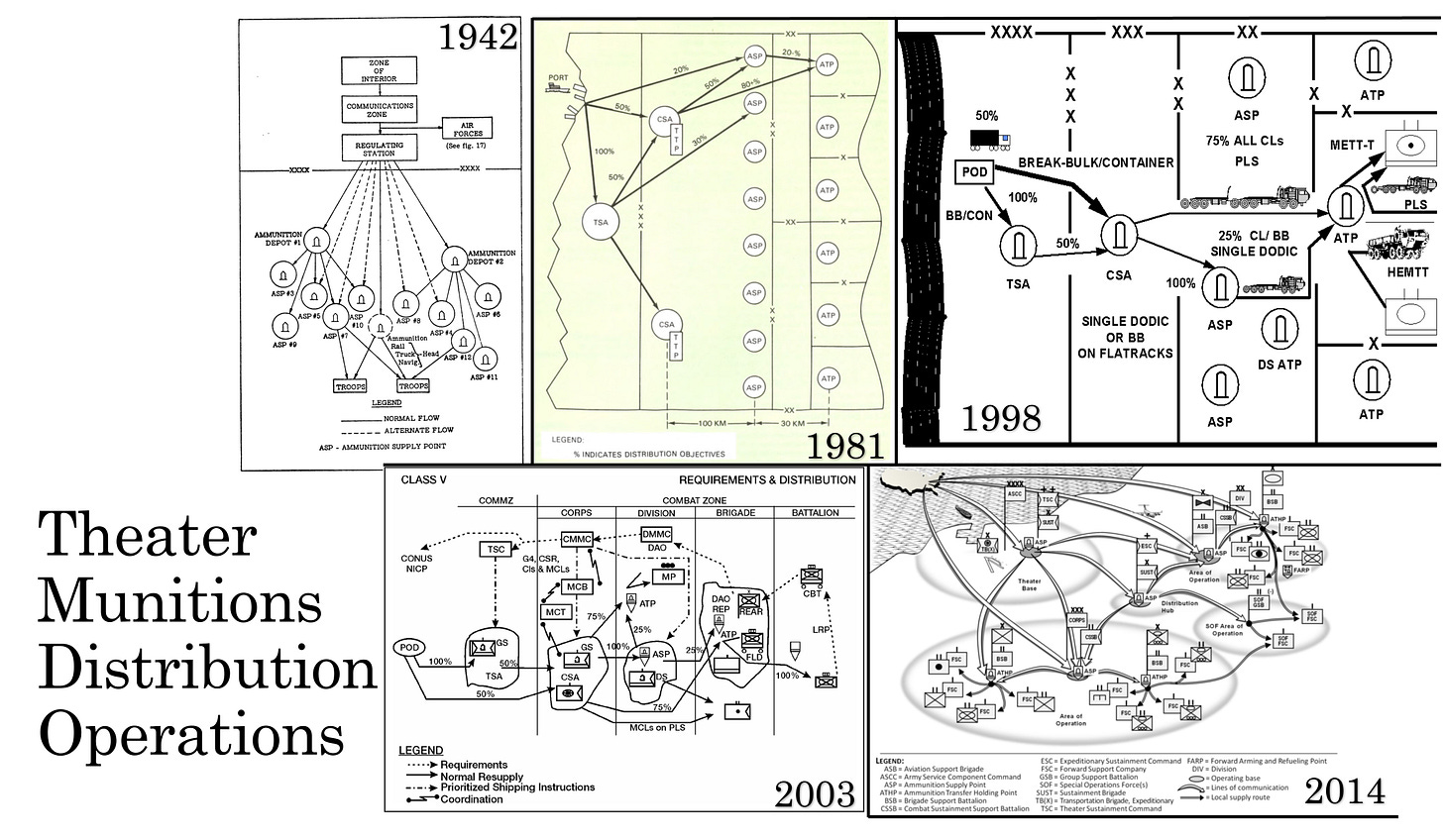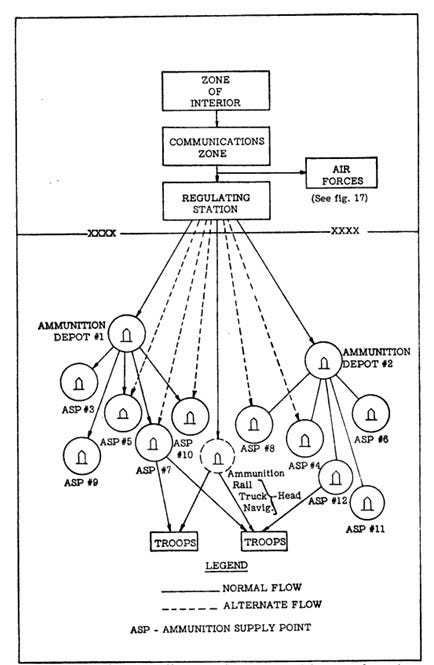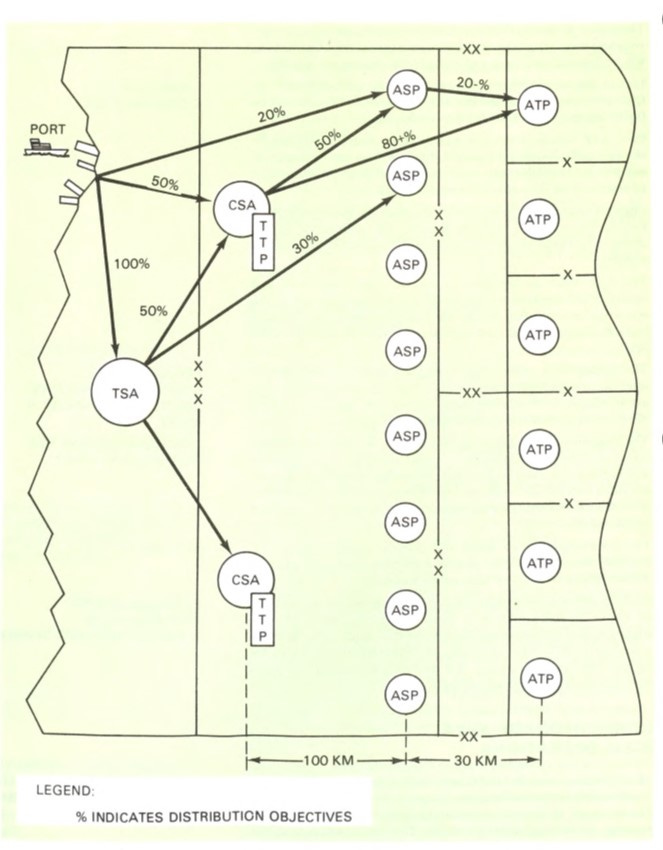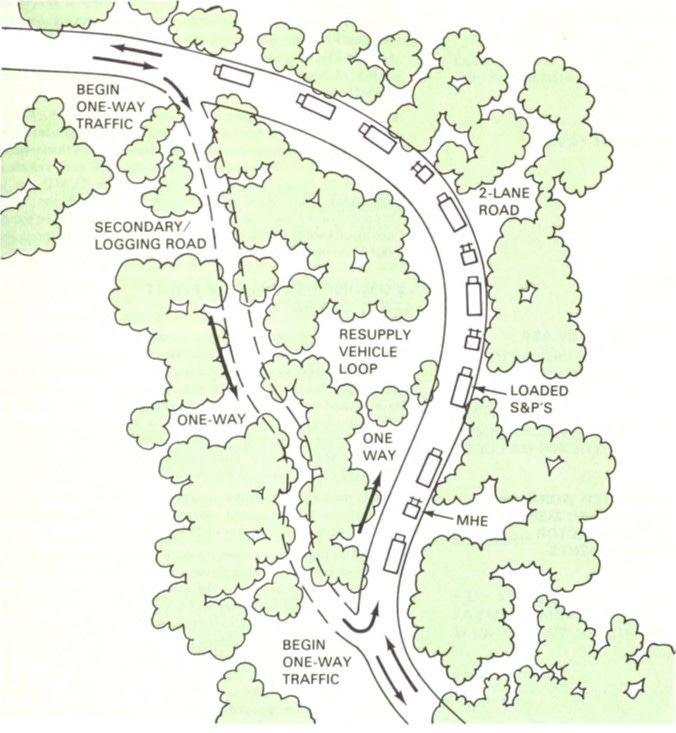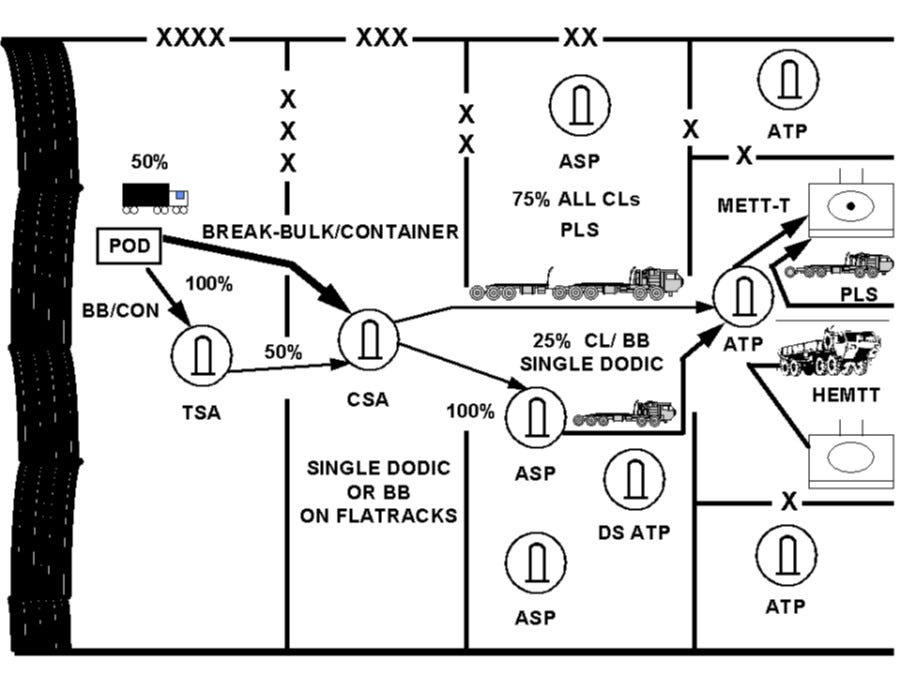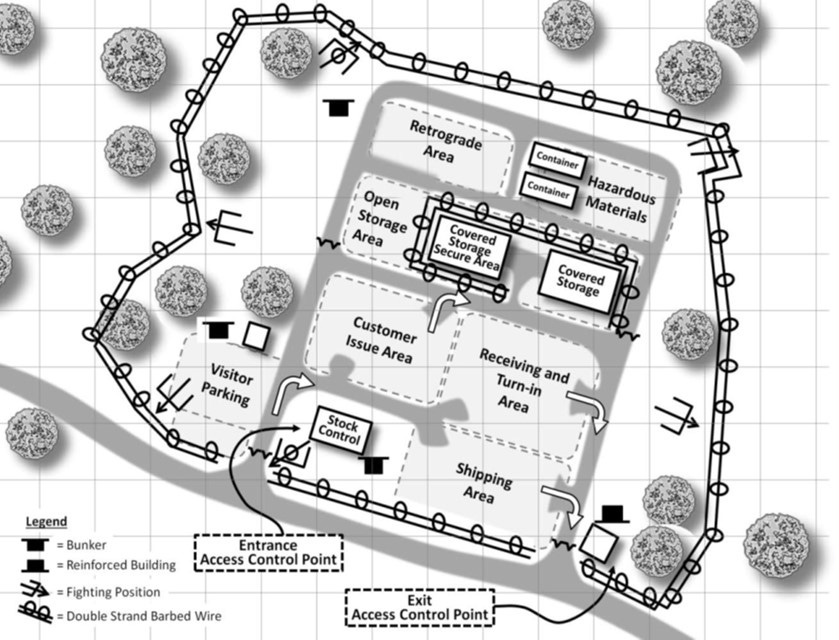Theater Munitions Distribution Operations: Historical Perspective, Current Operations, and Future Implications
The quote “History doesn’t repeat itself, but it often rhymes” is often attributed to the author Samuel Clemens know as Mark Twain. He was not a military general, but his statement does reflect the value of investigating the past for lessons in the future. As the United States transitions from nearly two decades of counter-insurgency to peer threats, a fundamental shift has taken place in doctrine directly behind the AirLand Battle, to the updated Multi-Domain Operations (MDO). In MDO, ground large scale combat operations would occur with land components of military services. Munitions distribution operations would build and sustain combat power for units participating in combat and allow commanders an operational pace unmatched by the enemy. This article discusses the historical context of munitions distribution operations from 1942 to present doctrine, multi-domain operations, and the lessons that can be used for future theater ammunition operations.
Ammunition Supply 1942
The 1942 Ammunition Supply, Ordnance Field Manual 9–6, was the premier publication for ammunition and provided information and guidance to U.S. Army. At the time, the United States Army Chief of Staff General George C. Marshall emphasized the following:
The importance of ammunition supply to the success of the military effort cannot be overemphasized. This importance as well as the difficulty of ammunition supply will increase with the stress of the situation. Plans for ammunition supply must not only provide a sound scheme to support the commander’s plan of operations but must also visualize alternative procedures in order to obtain the flexibility required to meet the varying conditions and unforeseen factors of modern warfare.[i]
The United States entered World War II in December 1941. The doctrine developed in the 1940s guided ammunition in theater for large scale combat operations, with noticeable variations from the doctrine of the post 9-11 Army. The 1942 ordnance field manual provides descriptions for the various ammunition support activities:
· Ammunition depot. An organized locality for the reception, classification, and issue of ammunition. Army ammunition depots are located in the army service area and, in general, are situated not more than 30 miles from the front.[ii]
· Ammunition supply point (ASP). Supply points in the corps and division service areas. They will be normally located from 8 to 20 miles from the front.[iii]
· Distributing point. A place, other than a depot, ASP, or railhead, where supplies are issued to regiments and Smaller units. Distributing points are designated by the class of supplies therein, and by the identity of the unit establishing them, such as Ammunition Distributing Point, 1st Infantry.[iv]
· Dump. A temporary Stockage of Supplies established by a corps, division, or smaller unit. When supplies are ordered issued from dumps, the latter become distributing points. Dumps are designated by the identity of the unit establishing them and by the class of Supplies therein, such as 1st Infantry Ammunition Dump.[v]
· Rolling Reserve. An accumulation of ammunition in excess of immediate needs for the purpose of ensuring continuity of adequate supply. It is kept all the times on either motor or rail transportation for immediate movement as may be required.[vi]
The theater of operations was divided into two zones, the communications and combat zone—shipments to the communications zone, which an Army Service Component Command would manage today. The transport from the communications zone to ammunition depots in the combat zone was accomplished by motor truck, but primarily with rail.[vii] Then transportation within the combat zone railhead to the ASP is by quartermaster truck.[viii] Then finally, forward of the ASP, it would be by unit motor transportation of the unit drawing the ammunition.[ix] The movement of ammunition from the communications zone to troops is depicted in figure 1, which will require the new movement by mobile means.
Figure 1. A schematic diagram of an ammunition supply system (1942).
In combat operations, the Army provides close support to its divisions and corps by retaining its reserves of ammunition loaded either on trucks or on railroad cars, which are the rolling reserve.[x] The basis of resupply of ammunition for dumps sites is to stock initially from ammunition trains as soon as troops arrive into an assembly area.[xi] Ammunition trains then commence hauling between army supply points and dumps until the desired amount of ammunition supply is accumulated.[xii] The 1942 Ordnance doctrine provided a relatively simple system for ammunition supply at the tactical level. That could be used by soldiers to meet the extreme need for World War II. The 1942 doctrine stated that “indispensable requirements of any supplied service which can hope to function successfully under combat conditions are simplicity, mobility, flexibility, and security.”[xiii] In August 1944, to get the ammunition forward to the fast-moving First Army, the Ordnance Officer Colonel Medaris organized a large-scale mobile ASP operated to any extent by any of the armies.[xiv] The innovation provided the genesis of forward ammunition support to the unit level.
Ammunition Supply 1944
The modern-day Ammunition Transfer and Holding Point (ATHP) did not originate until the 1944 ammunition supply Ordnance Field Manual. The term was transfer point and read far different than current doctrine but included major transportation modes. The term was described as:
Transfer points. In addition to depots and ASPs, the ammunition supply system usually requires ammunition railheads, navigation heads, and truck-heads. These are transfer points at which ammunition is unloaded and reloaded for reshipment or issue. In these places ammunition is stored for very short periods of time, seldom longer than one day, and, in many cases the unloading and reloading is done in one operation. Under certain conditions using units may draw from railheads or truck-heads. The ammunition is unloaded and reloaded directly into using unit trains, which meet the incoming rail or truck shipments. When ammunition is issued to using units at railheads or truck-heads, they are also supply points.[xv]
The cross of transfer and supply point was the pillar of ammunition supply, the ability to have ammunition as far forward as possible to the front-line troops. Ammunition transfer points at railheads using current rail systems already in theater. Or through the use of navigation heads using inland waterways. But ultimately the use of truck-heads utilizing roads. The method of moving ammunition can be done by multiple means, but the support of moving as far forward as possible remains the same and continues to this day.
Ordnance Service 1955
By the time of the 1955 ordnance ammunition service in the field, the ammunition supply was based on a continuous refill system. Where tactical units are responsible for maintaining a basic load of ammunition and replenishment of ammunition was concurrent with an immediate requirement.[xvi] The withdrawals from ammunition supply points are replenished by shipments from the army ammunition depot and stock levels to be maintained in ammunition installations of the armies.[xvii] The phasing procedures follow a similar path in what would be required in modern-day offensive operations with a peer nation. The 1955 troop phasing described the procedures as the following:
The first ammunition and depot type units to move into a theater should be of the army type but should be sufficient only for the direct support of combat elements until the theater has expanded to a point where support of ASP’s and maintenance battalions cannot adequately be provided from the base installations. Communications zone type units should be brought in as soon as possible to take over the initial establishments, to develop them as base installations, and to receive, store, and document the large flow of reserves which must be accumulated. Not until about D plus 60 days will it be necessary to bring in additional army type units for the establishment of new army depots. From that time on, ammunition and depot companies of the army type should be brought into the theater in numbers proportionate to the combat elements to be supported.[xviii]
The next 30 years provided the time and lessons of war, such as the Korean and Vietnam War, for Army ammunition doctrine to develop tactical operations. At the same time, the period provided revisions to commands at the theater level. The advent of chemical and nuclear munitions added another layer to the ammunition support system. Additionally, the publication incorporated the ammunition transfer point at what is now considered the tactical level of operations.
Ammunition Service Support 1981
The updated doctrine authorized the storage activities with the theater storage area (TSA), corps storage area (CSA), ammunition supply point (ASP), and the ammunition transfer points (ATP). These now made up the critical functional storage locations within the communication and combat zones, as seen in figure 3. The ATP moved forward to the units providing a location to transfer ammunition as depicted in figure 4.
The concept of the ATP was for the location to establish in the rear brigade area, to reduce the travel distances of unit resupply vehicles carrying items that are high usage and tonnage.[xix] Efficient flow of ammunition for the Ammunition Transfer Point (ATP) with a projected rated capability of 450 to 600 short tons per day, was described as follows:
The key to a smooth efficient flow of ammunition into the ATP is the timely arrival of convoys from CSA. The procedure for replenishing the ASP stocks with one large convoy per day will not satisfy the ATP concept of operation. During periods of medium to heavy engagement, CSA convoys must arrive at the ATP every three to four hours. The lag time between the “call forward” and the arrival time of the convoy is estimated to be 8 to 10 hours. Stocks destined for the ATP will be inspected by CSA personnel to verify the contents of the S&Ps [stake and platform], condition of the stocks, and lot numbers prior to release.[xx]
The ability to move and transfer the projected tonnage was based on the use of 31⁄2-ton stake and platform (S&P) drop-side trailers to move ammunition from corps storage areas to the transfer points.
Figure 2. Conventional Ammunition Support (1981).
Figure 3. Ammunition Transfer Point (ATP) Layout (1981).
One of the critical aspects of the supply ammunition system was the trailer transfer point (TTP). The TTP was used as a staging area for convoys of throughput vehicles at each CSA, used to transload containers going forward to the ASP.[xxi] Additionally, doctrine begins to see a recommended percent of ammunition support by support activity, with 100% of ammunition from the port supporting the theater storage area.[xxii] And the ammunition transfer points receiving 80/20 percent split between the corps storage area and the ammunition supply point, respectively. The next update to doctrine changed from the improvement in transportation technology.
Munitions Support 1998
The doctrine of 1998 incorporated the maneuver-oriented ammunition distribution system, palletized load system (MOADS-PLS). The MOADS-PLS allowed for the extensive use of palletized load system for the distribution of ammunition.[xxiii] Additionally, the updated publication incorporated the modular ammunition platoon concept, with the heavy-lift and medium-lift. The heavy-lift platoon (HLP) suited for port operations, theater storage area (TSA), and corps storage area (CSA).[xxiv] Medium lift platoons (MLPs) designed to operate ammunition supply points (ASPs).[xxv] The units effectively used the transportation technology of the palletized load system and incorporated strategic and mission configured loads (MCLs) shipped to TSAs, CSAs, and ASPs.[xxvi] Modularity provided the units the flexibility to scale up or down to meet the mission at hand. Combat Operations that required more extensive TSA would just increase the number of HLP or the number of MLPs dependent on the operational need.
The 1998 doctrine had three types of Ammunition Support Activities in the theater the TSA, CSA, and the ASP, but removing the ammunition transfer point (ATP) as it was considered temporary nature.[xxvii] The removal of the ATP because the temporary occurrence was just the nature of a particular period before the war on terrorism. The ammunition supply doctrine post 9-11 had a significant shift to keep up with the ever-evolving nature of the enemy.
Figure 4. The flow of munitions in a theater of operations (1998).
Munitions Distribution 2003
In Operation Iraq Freedom, the Army used a palletized loading system (PLS), configured loads (CLs), and containerized roll-on/-off platforms (CROPs). The 2003 doctrine has the TSA as a permanent or semi-permanent storage facility, that could expand up to 40-square kilometers.[xxviii] A CSA, with a stockage objective of 25,000 STONs, would typically be required to support ASP and ATP operations for each committed division.[xxix] In combat operations, each ASP is a field site and operated by one or more MLPs.[xxx]
The ammunition transfer points provide the ability to be mobile and the flexibility required for changing combat operations. The ATP would receive about 75 percent of their ammunition as throughput from the CSA and 25 percent from an ASP in the form of combat loads loaded on flatracks, which would be transferred to the receiving unit’s organic vehicles.[xxxi] The next decade of combat brought doctrine to the most current standard with the modular force that would fight in counter-insurgency operations.
Figure 5. The flow of munitions in a theater of operations (2003).
Munitions Operations and Distribution 2014
The 2014 publication implemented unified land operations, updated to the levels of munitions support operations, and the changes to the distribution structure. One concept that has not changed is that ammunition organizations maximize throughput distribution to support the theater of operations.[xxxii] One significant change is now there are only two types of ammunition support activities in the theater, the ASP and the ATHP. The ammunition supply points can be field, semi-fixed or permanent storage areas of various sizes.[xxxiii] The second significant change is the creation and update of the ammunition transfer holding points (ATHP), which are small, temporary holding areas.[xxxiv] The two system architecture for a modular system allows for growth as operationally required, as depicted in figure 7. Munitions operations and distribution 2014 defined the ASP as:
The ammunition supply point is the primary ASA at echelons above brigade. The ASP may be located throughout a joint operations area to include ports of debarkation, at in-land locations providing theater distribution or in close proximity to supported brigade combat teams. The ASP provides support to tactical brigade ammunition transfer holding points and units not supported by an ATHP. Ammunition supply points receive, store, issue, and maintain a one-to-three day supply of ammunition to meet a routine surge and emergency requirements for supported units.[xxxv]
Ammunition transfer holding points while updated from previous publications no longer regulated the point as just transfer but holding munitions as required. The ATHP is defined as:
The ammunition transfer holding point is established and operated by the ATHP section of the brigade support battalion distribution company. The ATHP is an operation established to facilitate the receipt and transfer of all types of ammunition from echelons above brigade ammunition storage activities to units within a brigade. Under most circumstances the ammunition transfer holding point is a temporary operation located in the brigade support area to facilitate rapid receipt and issue of ammunition to the users [see figure 8].[xxxvi]
The ATHP used at the brigade level and received their ammunition usually delivered on flat racks from echeloned ammunition supply point(s) and a portion as configured items from the theater ASP.[xxxvii] The ammunition transfer holding point provides the increased capacity for forward operating bases in contested areas of operations. Future conflicts will see an increase in unconventional warfare against near-peer advisories, but that does not mean insurgencies cease to exist.
Figure 6. Notional ammunition unit alignment in a theater of operations (2014).
Figure 7. The notional layout of an ammunition transfer holding point (2014).
Multi-Domain Operations 2018
The U.S. Army Training and Doctrine Command proposed a definition of Multi-Domain Operations (MDO) as operations that are conducted across multiple domains and contested spaces to overcome an adversary’s strengths by presenting them with several dilemmas through the combined application of force posture; multi-domain formations; and capabilities across domains to achieve objectives.[xxxviii] Ammunition distribution operations will have to face operations in both a contiguous and noncontiguous area of operations, as seen in figure 9. Theater munitions distribution operations have already undergone a redesign with the Modular Ammunition Transfer Point (MATP). The updated design provides the BCT commander the ability to scale, tailor, and surge Class V capability and capacity required to sustain combat power during widely dispersed areas of operation.[xxxix] In contrast, peer adversaries take a more significant role in military plans. A modular transfer point may lack breadth in contested spaces in a noncontiguous area of operations. Without a dedicated theater and corps storage areas, there may also be a lack of depth required for large scale combat operations.
Figure 8. Contiguous and Noncontiguous corps area of operations (FM 3-0, 2017).
Conclusion
From the origins of the 1942 ordnance rolling reserve and mobile ASP to the redesign of the Modular Ammunition Transfer Point (MATP), the doctrine may have come to full circle if munitions are maintained at the ammunition supply point as the lowest level to support units. Theater munitions distribution operations must be prepared for both contiguous and noncontiguous support in the theater area of operations. Ammunition Transfer Points are required for fast-moving fronts during large scale combat operations. Additionally, ammunition transfer holding points are essential for forward operating bases in a contested area of operations without a linear front. Doctrine provides a reference point for planning combat operations, but only combat will provide battle-tested ordnance soldiers. That will have to provide the means for simplicity in operations that can also have the mobility and flexibility to face the enemy, and at the same time, provide a means for security. Theater munitions distribution operations will have to be ever-evolving to the nature of war. Still, the lessons of the past must not be forgotten as the U.S. military moves into a new battlefield.
[i] War Department, Ordnance Field Manual, Ammunition Supply, FM 9–6 (Washington, DC: United States Government Printing Office, 1942).
[ii] Ibid.
[iii] Ibid.
[iv] Ibid, 1.
[v] Ibid, 2.
[vi] Ibid, 3.
[vii] Ibid, 16.
[viii] Ibid.
[ix] Ibid.
[x] Ibid, 27.
[xi] Ibid, 30.
[xii] Ibid.
[xiii] Ibid
[xiv] Lida Mayo, The Ordnance Department: On Beachhead and Battlefront, CMH Pub 10-9 (Washington, DC: The Technical Services. Center of Military History, 1991).
[xv] War Department, Ordnance Field Manual, Ammunition Supply, FM 9–6 (Washington, DC: United States Government Printing Office, 1944).
[xvi] Department of the Army, Ordnance Service in the Field, Ammunition Supply, FM 9–6 (Washington, DC: Department of the Army, 1955).
[xvii] Ibid.
[xviii] Ibid, 65.
[xix] Department of the Army, Ammunition Service Support in the Theater of Operations, FM 9–6 (Washington, DC: Department of the Army, 1981).
[xx] Ibid, 38.
[xxi] Ibid, 43.
[xxii] Ibid.
[xxiii] Department of the Army, Munitions Support in The Theater of Operations, FM 9–6 (Washington, DC: Department of the Army, 1998).
[xxiv] Ibid.
[xxv] Ibid.
[xxvi] Ibid.
[xxvii] Ibid, 2-1.
[xxviii] Department of the Army, Munitions Support in The Theater of Operations, FM 4-30.1 (FM 9–6) (Washington, DC: Department of the Army, 2003).
[xxix] Ibid.
[xxx] Ibid, 2-3.
[xxxi] Ibid, 2-4.
[xxxii] Department of the Army, Munitions Support in The Theater of Operations, ATP 4-35 (FM 4-30.1) (Washington, DC: Department of the Army, 2014).
[xxxiii] Ibid, 4-4.
[xxxiv] Ibid.
[xxxv] Ibid, 4-5.
[xxxvi] Ibid, 4-6.
[xxxvii] Ibid, 4-7.
[xxxviii] U.S. Army Training and Doctrine Command, The U.S. Army in Multi-Domain Operations, 2028, TRADOC Pamphlet 525-3-1 (Washington, DC: Department of the Army, 2018).
[xxxix] Ana Valencia, “MATP: Class V Scalability for the BCT Commander,” The Ordnance Corps Quarterly, Volume 4, Issue 4, (June 2019): 8. https://goordnance.army.mil/newsletters/2019/Ordnance-Quarterly-Newsletter-JUN19.pdf


